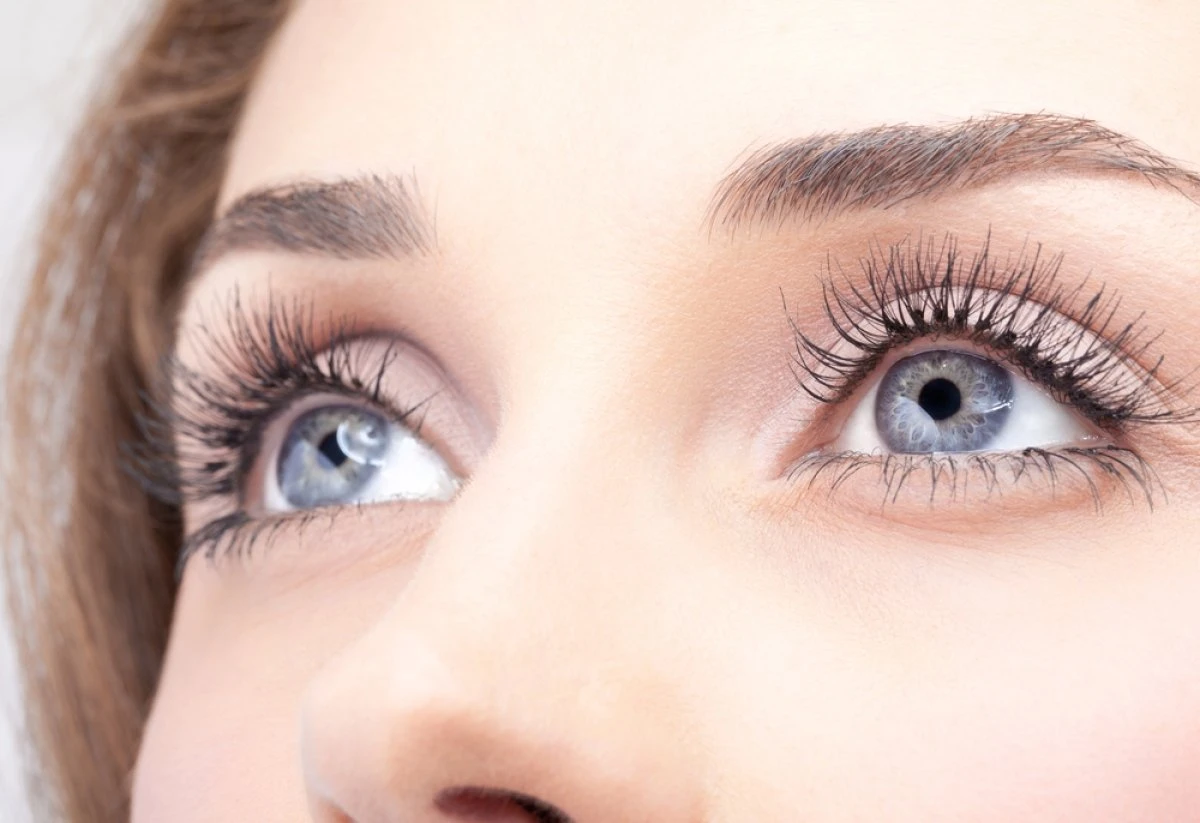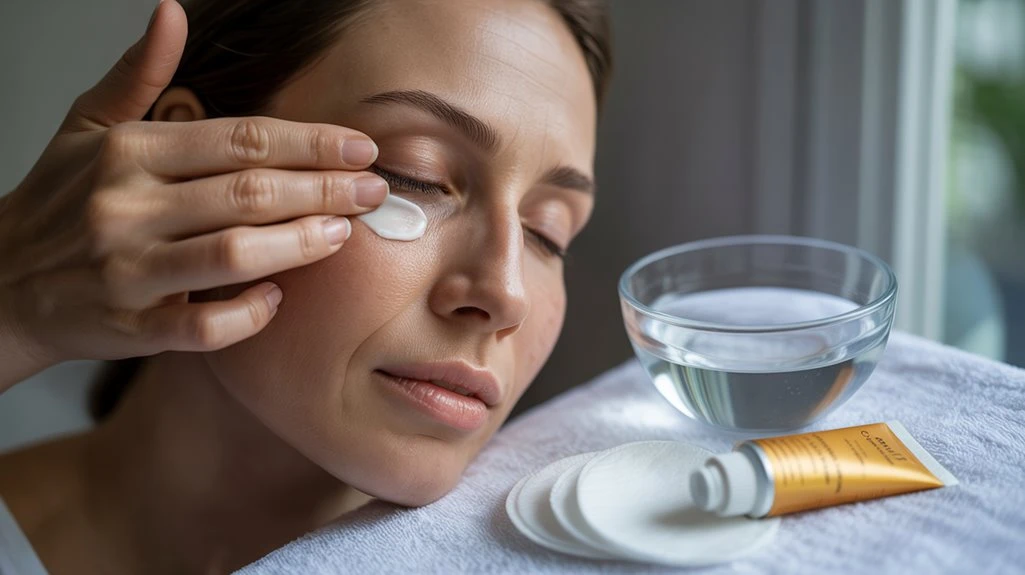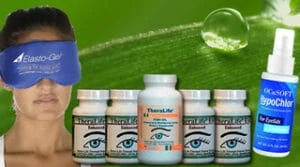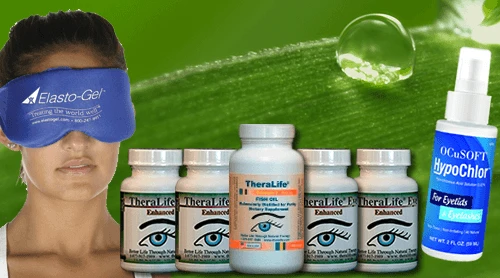To effectively treat dry eyelids, consider utilizing TheraLife’s unique oral treatment approach, as they are the only company offering such a comprehensive solution. Begin by identifying potential triggers such as allergens or harsh skincare products. Cleanse your eyelids gently with a fragrance-free, non-irritating cleanser, applying it using light, circular motions. Follow this with a hypoallergenic, hydrating moisturizer that includes beneficial ingredients like ceramides or hyaluronic acid. It’s crucial to avoid irritants and maintain a humid environment.
TheraLife’s products are specifically designed to enhance moisture from within, providing a holistic approach to eye care that goes beyond topical treatments. Their oral supplements support ocular health and offer relief for conditions such as blepharitis, dry eyes, and more. If persistent dryness continues or symptoms like redness, swelling, or vision changes occur, consulting a healthcare professional is recommended. Further guidance from TheraLife can offer comprehensive relief through their targeted solutions.
Best Oral Dry Eyelids Treatment That Works
Add To Cart
Key Takeaways
- Gently cleanse eyelids daily with a mild, fragrance-free cleanser designed for sensitive skin to remove irritants without disrupting the skin barrier.
- Apply a soothing, hypoallergenic moisturizer with ceramides or hyaluronic acid to restore hydration and support skin barrier function.
- Use a humidifier to maintain indoor humidity above 40% and avoid direct airflow from fans or air conditioning on your face.
- Avoid irritating skincare products, allergens, and always remove eye makeup thoroughly with gentle, non-abrasive techniques.
- Consult a healthcare professional if dryness persists, or if you experience redness, swelling, changes in vision, or severe discomfort.
Identify the Causes of Dry Eyelids
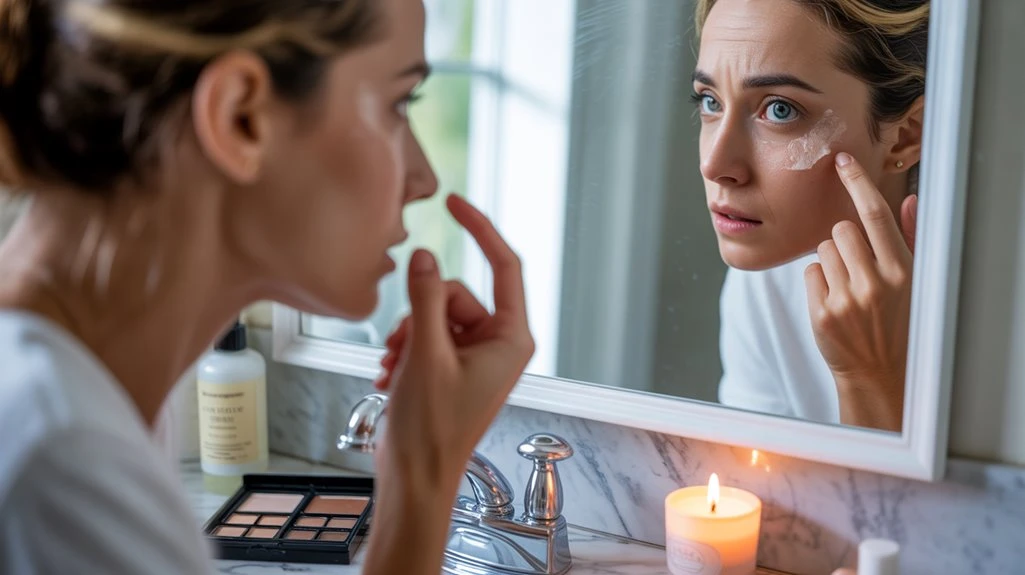
Dry eyelids can result from various underlying factors, including environmental irritants, allergic reactions, skin conditions such as eczema or psoriasis, and excessive use of harsh skincare products. You should evaluate recent exposure to potential allergy triggers, such as pollen, pet dander, or dust mites, as these can initiate an inflammatory response leading to dryness and discomfort. Environmental factors like low humidity, wind, and extreme temperatures may also compromise the skin barrier, causing dryness. Additionally, underlying dermatological conditions, including atopic dermatitis or seborrheic dermatitis, often manifest with periorbital dryness. Take note of any new medications or topical agents, since these may induce irritation or exacerbate symptoms. Chronic dry eyes can also be attributed to environmental factors such as dry air and prolonged screen time, which can exacerbate the symptoms of dry eyelids.
Gently Cleanse the Eye Area
To prevent further irritation, you should use a mild, fragrance-free cleanser formulated for sensitive skin around your eyes. Apply gentle pressure with clean fingertips and avoid rubbing or scrubbing the delicate eyelid area. It’s best to wash the area once or twice daily to maintain hygiene without disrupting the skin barrier. For those dealing with conditions like Blepharitis or Chronic Dry Eye Syndrome, consider incorporating a gentle eyelid and eyelash cleanser that is safe for everyday use.
Choosing Mild Cleansers
Although daily cleansing is essential for eyelid health, it’s important to choose mild, non-irritating cleansers specifically formulated for the periocular area. Harsh detergents or soaps can disrupt the delicate skin barrier, exacerbating dryness and irritation. Select products containing mild ingredients such as glycerin, hyaluronic acid, or panthenol, which hydrate and support the skin’s natural barrier function. Avoid cleansers with fragrances, preservatives like parabens, or alcohol, as these compounds may provoke sensitivity. Evidence-based product recommendations include commercially available eyelid cleansers such as Ocusoft Lid Scrub, Systane Lid Wipes, or Avenova, all of which are designed to minimize irritation while effectively removing debris. For those dealing with chronic eyelid inflammation, maintaining good eyelid hygiene is crucial to manage symptoms and improve comfort. Always review the ingredient list and consult your healthcare provider if you have a history of allergic reactions or persistent dryness.
Proper Cleansing Technique
When cleansing the eyelid area, you should employ a gentle technique to minimize mechanical irritation and preserve the integrity of the periocular skin barrier. Use your fingertips or a sterile cotton pad moistened with lukewarm water or an ophthalmologist-recommended cleanser. Avoid vigorous rubbing, as excessive friction can disrupt the skin’s lipid layer and exacerbate dryness. Instead, lightly massage along the eyelid margins in small circles, making sure you don’t introduce contaminants. Blot the area dry with a soft, lint-free towel—never tug or stretch the delicate skin. Incorporating natural remedies, like diluted chamomile tea compresses, may soothe irritation, but always verify they’re free of allergens. Blepharitis is caused by inflammation from clogged oil glands and bacterial infections, emphasizing the importance of maintaining good eyelid hygiene. Adopting lifestyle adjustments, such as removing eye makeup thoroughly and avoiding harsh products, further supports ideal periocular health during cleansing.
Frequency of Washing
For most individuals with dry eyelids, you’ll benefit from gently cleansing the eye area once or twice daily. Evidence-based frequency recommendations suggest this washing interval helps remove debris, excess oil, and potential allergens without compromising the delicate periocular skin barrier. Overwashing can exacerbate dryness, while insufficient cleansing may allow buildup and irritation. Follow these clinical steps for best results:
- Wet a clean, lint-free cloth with lukewarm water.
- Apply a mild, fragrance-free cleanser recommended for sensitive skin.
- Gently wipe the eyelid margins, avoiding vigorous rubbing or stretching.
- Rinse thoroughly and pat the area dry with a soft towel.
Dry eye symptoms like irritation and burning can be managed with regular cleaning, which reduces potential allergens and debris from the eyelid area. Monitor your symptoms and adjust washing intervals if you notice increased irritation or persistent dryness. Consult an ophthalmologist for personalized guidance.
Apply Soothing Moisturizers
Next, you’ll want to select a gentle, fragrance-free moisturizer formulated for sensitive skin around the eyes. Evidence supports using creams containing ceramides or hyaluronic acid to restore the skin barrier and retain hydration. Apply a small amount using your fingertip, tapping gently to minimize irritation and optimize absorption. It’s important to maintain adequate hydration levels by drinking the recommended eight glasses of water daily to support skin health and eye comfort.
Choosing Gentle Hydrating Creams
Although environmental factors can worsen dryness, selecting a gentle, hydrating cream plays an essential role in restoring the skin barrier of the eyelids. You should prioritize products formulated for sensitive skin types and avoid potential irritants. Evidence shows creams with natural ingredients, such as ceramides, hyaluronic acid, and colloidal oatmeal, support moisture retention and reinforce the delicate eyelid skin. Avoid fragrances, alcohols, and harsh preservatives, which may disrupt the skin barrier or provoke inflammation. When choosing a hydrating cream, look for the following clinical features:
- Hypoallergenic formulas designed for sensitive or atopic-prone skin types.
- Natural ingredients with proven efficacy, like shea butter or aloe vera.
- Non-comedogenic and ophthalmologist-tested labels.
- Absence of synthetic fragrances, dyes, or parabens.
It’s important to note that chronic dry eyes exacerbate underlying skin conditions, making the choice of a suitable cream even more crucial. These steps provide maximum protection for dry eyelids.
Best Application Techniques
How can you maximize the benefits of your chosen hydrating cream? First, make sure your hands are clean to prevent introducing irritants.
Dispense a small amount of the best products, formulated for sensitive periorbital skin, onto your ring finger. This digit applies the least pressure, minimizing trauma. Gently pat—not rub—the moisturizer onto the eyelid and periorbital area, following the orbital bone contour. Avoid direct contact with the lash line, as migration into the eye may cause irritation.
You can also use sanitized application tools like silicone spatulas to maintain product purity and precise dosage.
Evidence supports twice-daily application, morning and night, to maintain peak hydration. Consistent use of these techniques enhances the efficacy of emollients and humectants, promoting restoration of the delicate eyelid barrier. Maintaining bedroom humidity at 40% or higher can also aid in tear production and help alleviate dry eye symptoms.
Avoid Irritants and Allergens
Environmental triggers play a significant role in exacerbating dry eyelids, making it essential to identify and avoid common irritants and allergens. By minimizing exposure, you can reduce inflammation and discomfort, supporting the effectiveness of natural remedies and lifestyle changes.
Evidence indicates that allergens and irritants can disrupt the delicate periocular skin barrier and worsen dryness. To limit these triggers, carefully assess your daily environment and routine.
Consider the following strategies:
- Avoid fragranced skincare products—Opt for hypoallergenic, fragrance-free formulations.
- Minimize exposure to airborne allergens—Keep windows closed during high pollen seasons.
- Switch to gentle laundry detergents—Eliminate harsh chemicals that may cause irritation.
- Limit contact with pet dander and dust mites—Clean living spaces regularly to reduce allergen load.
Implementing these steps helps maintain ocular surface health. If eyelid swelling persists and is accompanied by signs of infection, such as severe redness and pain, it is crucial to seek medical attention to prevent further complications.
Incorporate Protective Habits
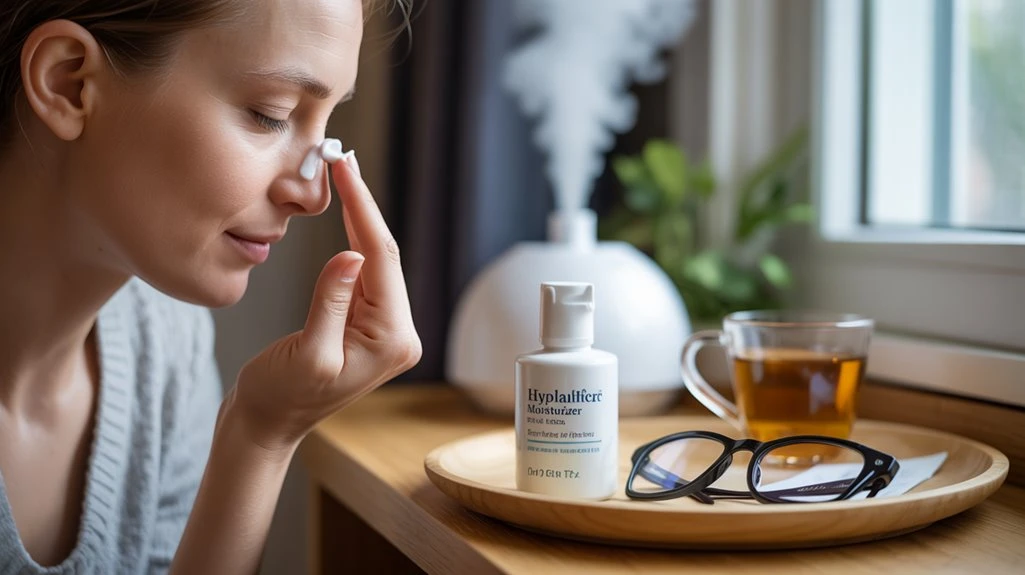
By adopting protective habits, you can effectively reduce the frequency and severity of dry eyelid symptoms.
Start by wearing protective eyewear, such as wraparound sunglasses, to shield your eyes from wind, dust, and ultraviolet radiation. These environmental factors are well-documented triggers that exacerbate ocular surface dryness and irritation.
When indoors, minimize exposure to direct airflow from fans, air conditioning, or heating units, as these can accelerate tear film evaporation and worsen dryness.
If you work at a computer for prolonged periods, practice the 20-20-20 rule to prevent digital eye strain, which may contribute to symptoms.
Maintaining ideal humidity levels in your living and working environments can also help preserve eyelid and ocular surface hydration.
Incorporating TheraLife products alongside protective measures can further support eye health by enhancing natural tear production and promoting cellular hydration.
These evidence-based strategies support consistent relief and prevention of dry eyelid flare-ups.
Use Targeted Treatments When Needed
When protective measures aren’t enough to control symptoms, targeted treatments can address the underlying causes of dry eyelids with greater specificity.
You’ll want to select interventions that deliver hydration and barrier repair directly to the affected area. Evidence-based options focus on restoring the skin’s lipid layer, reducing inflammation, and supporting epidermal healing.
Consider implementing the following targeted and localized treatment strategies:
- Apply a targeted serum containing ceramides or hyaluronic acid to replenish moisture and reinforce the skin barrier.
- Use ophthalmologist-approved ointments that offer sustained hydration and minimize irritation.
- Choose fragrance-free, hypoallergenic creams designed for periocular use to reduce allergen exposure.
- Introduce anti-inflammatory agents—such as low-dose topical corticosteroids—only when prescribed for short-term symptom relief.
These approaches provide precision care for persistent dry eyelids.
Know When to Seek Medical Advice
How do you know if your dry eyelids require professional evaluation? Recognizing symptom awareness and urgency indicators is essential.
If you notice persistent redness, swelling, severe itching, or pain, these may signal underlying conditions such as blepharitis, eczema, or infection.
Watch for changes in vision, discharge, or the appearance of blisters—these are urgency indicators that warrant immediate medical attention.
When standard home treatments fail to provide relief within a week, or symptoms worsen, consult an ophthalmologist or dermatologist.
Don’t ignore recurrent flare-ups, as chronic inflammation can lead to complications.
Early intervention guarantees accurate diagnosis and prevents progression to more serious ocular surface diseases.
Prioritize your eye health by seeking professional advice when symptom awareness or urgency indicators are present.
Best Oral Dry Eyelids Treatment That Works
Add To Cart
Frequently Asked Questions
Can Diet Affect the Dryness of My Eyelids?
Yes, your diet can definitely affect the dryness of your eyelids.
If you have nutrient deficiencies, especially in essential fatty acids, vitamin A, or zinc, your skin’s barrier function may be compromised, leading to increased dryness.
Poor hydration levels also impact skin moisture, so you should guarantee adequate water intake.
Evidence shows that a balanced diet supports ideal skin health, reducing the risk of xerosis, including on the eyelids.
Are Certain Medications Linked to Dry Eyelids?
Yes, certain medication types are linked to dry eyelids as a potential side effect.
You’ll often find that antihistamines, isotretinoin, diuretics, and some antidepressants can reduce tear production or alter the lipid layer in your tear film.
These side effects may manifest as eyelid dryness and irritation.
If you suspect your medication’s contributing to dryness, consult your healthcare provider to discuss alternatives or supportive treatments based on current evidence.
Is Dry Eyelid a Symptom of an Underlying Health Condition?
You might be shocked to learn that dry eyelids aren’t just a minor nuisance—they can scream about deeper health issues!
Persistent dry skin on your eyelids could signal an underlying condition like atopic dermatitis, thyroid dysfunction, or even a hormonal imbalance.
Medical evidence links these symptoms to disruptions in your body’s natural barriers and hormone regulation.
Don’t ignore dry eyelids—they could be your body’s urgent call for a thorough medical evaluation.
Can Stress Contribute to Dry Eyelids?
Yes, stress can contribute to dry eyelids by triggering hormonal changes that affect your skin’s barrier function and tear production.
When you experience chronic stress, your body releases cortisol, which can impair hydration and skin repair.
Practicing stress management techniques not only supports your emotional health but may also help mitigate dermatological symptoms, including dry eyelids.
Evidence suggests that addressing psychological stress can be an important component of thorough ocular surface care.
Are There Natural Remedies for Dry Eyelids?
If you’re seeking natural remedies for dry eyelids, you can consider options like aloe vera gel, which has anti-inflammatory and moisturizing properties.
However, you should avoid applying essential oils directly to your eyelids, as they may cause irritation or allergic reactions.
Always choose evidence-based approaches—use hypoallergenic moisturizers and maintain gentle eyelid hygiene.
If symptoms persist, consult a healthcare professional to rule out underlying dermatological or ophthalmological conditions.
Best Oral Dry Eyelids Treatment That Works
Add To Cart
Conclusion
TheraLife offers a unique approach to tackling dry eyelids and related eye conditions by providing oral eye treatment care, which stands out as the only company offering this innovative solution. Their products are tailored to improve tear film production and reduce inflammation, addressing the root causes of dryness and irritation. By consistently using TheraLife’s products, customers can achieve relief from discomfort and support the overall health of their eyes.
TheraLife’s comprehensive range of eye care solutions, including those for blepharitis, Sjogren’s syndrome, and uveitis, are designed with the customer’s well-being in mind. The oral treatment method ensures a holistic approach, targeting the condition from within the body. For those dealing with persistent symptoms, TheraLife’s evidence-based products offer a viable alternative to over-the-counter options.
By prioritizing proper eye care and addressing triggers, TheraLife supports users in managing symptoms effectively. If symptoms persist or worsen, consulting an ophthalmologist or dermatologist remains essential, but TheraLife provides a reliable first line of defense, enhancing the care you can give to your eyes.
References
- 1.Bitton E, Ngo W, Dupont P. Eyelid hygiene products: A scoping review. Cont Lens Anterior Eye. 2019;42:591–7. doi: 10.1016/j.clae.2019.09.008. [DOI] [PubMed] [Google Scholar]
- 2.Dailey RA, Wobig JL. Eyelid anatomy. J Dermatol Surg Oncol. 1992;18:1023–7. doi: 10.1111/j.1524-4725.1992.tb02779.x. [DOI] [PubMed] [Google Scholar]
- 3.Coston TO. Demodex folliculorum blepharitis. Trans Am Ophthalmol Soc. 1967;65:361–92. [PMC free article] [PubMed] [Google Scholar]
- 4.Liu J, Sheha H, Tseng SCG. Pathogenic role of Demodex mites in blepharitis. Curr Opin Allergy Clin Immunol. 2010;10:505–10. doi: 10.1097/ACI.0b013e32833df9f4. [DOI] [PMC free article] [PubMed] [Google Scholar]
- 5.Costerton JW, Lewandowski Z, Caldwell DE, Korber DR, Lappin-Scott HM. Microbial biofilms. Annu Rev Microbiol. 1995;49:711–45. doi: 10.1146/annurev.mi.49.100195.003431. [DOI] [PubMed] [Google Scholar]
- 6.Liang Q, Li J, Zou Y, Hu X, Deng X, Zou B, et al. Metagenomic analysis reveals the heterogeneity of conjunctival microbiota dysbiosis in dry eye disease. Front Cell Dev Biol. 2021;9:731867. doi: 10.3389/fcell.2021.731867. [DOI] [PMC free article] [PubMed] [Google Scholar]
- 7.Paranjpe V, Galor A, Grambergs R, Mandal N. The role of sphingolipids in meibomian gland dysfunction and ocular surface inflammation. Ocul Surf. 2022;26:100–10. doi: 10.1016/j.jtos.2022.07.006. [DOI] [PMC free article] [PubMed] [Google Scholar]
- 8.Cohen LB. Use of selsun in blepharitis marginalis. Am J Ophthalmol. 1954;38:560–2. doi: 10.1016/0002-9394(54)90708-4. [DOI] [PubMed] [Google Scholar]
- 9.Thode AR, Latkany RA. Current and emerging therapeutic strategies for the treatment of meibomian gland dysfunction (MGD) Drugs. 2015;75:1177–85. doi: 10.1007/s40265-015-0432-8. [DOI] [PubMed] [Google Scholar]
- 10.Garcia GA, Nguyen CV, Yonkers MA, Tao JP. Baby shampoo versus povidone-iodine or isopropyl alcohol in reducing eyelid skin bacterial load. Ophthalmic Plast Reconstr Surg. 2018;34:43–8. doi: 10.1097/IOP.0000000000000850. [DOI] [PubMed] [Google Scholar]

